Adolphe Willette
Adolphe Léon Willette (30 July 1857, Châlons-sur-Marne – 4 February 1926, Paris) was a French painter, illustrator, caricaturist, and lithographer, as well as an architect of the famous Moulin Rouge cabaret. Willette ran as an "anti-semitic" candidate in the 9th arrondissement of Paris for the September 1889 legislative elections.
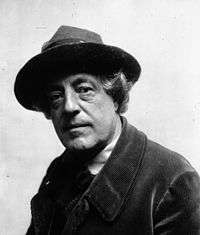
Biography
He studied for four years at the École des Beaux-Arts under Cabanel, training which gave him a unique position among the graphic humorists of France. Whether comedy or tragedy, dainty triviality or political satire, his work is instinct with the profound sincerity of the artist. He set Pierrot upon a lofty pedestal among the imaginary heroes of France, and established Mimi Pinson, frail, lovable, and essentially good-hearted, in the affections of the nation.[1]
Willette is at once the modern Watteau of the pencil, and the exponent of sentiments that move the more emotional section of the public. Always a poet, and usually gay, fresh, and delicate, in his presentation of idylls exquisitely dainty and characteristically Gallic, illustrating the more "charming" side of love, often pure and sometimes extremely materialistic. Willette frequently reveals himself bitter and fierce, even ferocious, in his hatreds, being a violent though at the same time a generous partisan of political ideas, furiously compassionate with love and pity for the people whether they be ground down under the heel of political oppression, or are merely the victims of unrequited love, suffering all the pangs of graceful anguish that are born of scornful treatment. There is charm even in his thrilling apotheosis of the guillotine, and in the introduction into his caricatures of the figure of Death itself.[1]
The artist was a prolific contributor to the French illustrated press under the pseudonyms "Cemoi", "Pierrot", "Louison", "Bebe", and "Nox", but more often under his own name. He illustrated Melandri's Les Pierrots and Les Giboulles d'avril, Le Courrier français, and published his own Pauvre Pierrot and other works, in which he tells his stories in scenes in the manner of Busch. He decorated several "brasseries artistiques" with wall-paintings, stained glass, &c., notably Le Chat noir and La Palette d'or, and he painted the highly imaginative ceiling for La Cigale music hall. His characteristically fantastic Parce Domine was shown in the Franco-British Exhibition in 1908. A remarkable collection of his works was exhibited in 1888. His V'almy is in the Luxembourg, Paris.[1]
Selected works
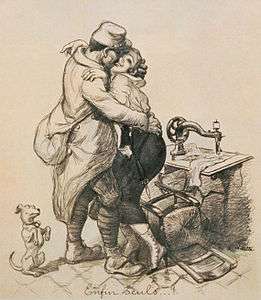 Journée du Poilu.
Journée du Poilu.
25 et 26 décembre 1915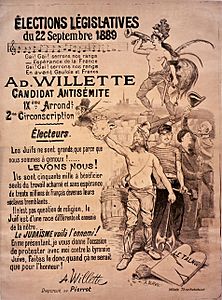 Anti-Semitic Election poster
Anti-Semitic Election poster
for Willette.jpg) Cacao Van Houten
Cacao Van Houten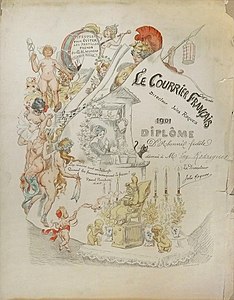 "Diploma" for a loyal subscriber to Le Courrier Français
"Diploma" for a loyal subscriber to Le Courrier Français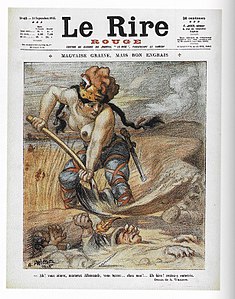 Cover of Le Rire Rouge. #43
Cover of Le Rire Rouge. #43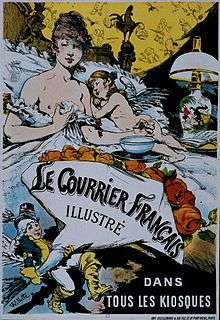 Poster for Le Courrier Français
Poster for Le Courrier Français.jpg) Exposition of works by Willete
Exposition of works by Willete
References
-

External links
| Wikimedia Commons has media related to Adolphe Willette. |